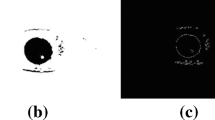Abstract
Iridology is the science and practice that helps to learn the health status through the examination of the structural aspects of an eye. Iris segmentation is an important phase in Iridology that aids to recognize iris signs and identify aberrant organ activity. The primary elements of iris segmentation are the detections of the iris and pupil. However, iris segmentation is greatly impacted by noises and images with low quality. The proper method for iris and pupil detection supports improving the result of iris segmentation in Iridology. This study provides a computer vision-based method to segment the human eye’s iris and pupil using an alternate method. The procedure is based on the red channel information of the image with various image processing operations. Iris images from the UBIRIS.v1. Dataset, which was taken in less restrictive image acquisition conditions, is used in an experiment. This method gives a unique way for iris segmentation with an accuracy of 97.49%.
Access this chapter
Tax calculation will be finalised at checkout
Purchases are for personal use only
Similar content being viewed by others
References
Jensen, B.: Visions of Health: Understanding Iridology. Penguin, New York (1991)
Iridology Chart: https://myinfiniteiris.com/product/updated-wallet-size-iridology-chart/
Pau, G.: The Foundations of Iridology: The Eyes as the Key to Your Genetic Health Profile. Simon and Schuster, New York (2019)
Esteves, R.B., Morero, J.A., Pereira, S.D., Mendes, K.D., Hegadoren, K.M., Cardoso, L.: Parameters to increase the quality of iridology studies: a scoping review. Eur. J. Integr. Med. 43, 101311 (2021)
Huda, A.L.: Iris detection using morphology. J. Univ. Babylon 22(9), 2277–2282 (2014)
Permatasari, L.I., Novianty, A., Purboyo, T.W.: Heart disorder detection based on computerized iridology using support vector machine. In: 2016 International Conference on Control, Electronics, Renewable Energy and Communications (ICCEREC), pp. 157–161 (2016)
Lestari, R.F., Nugroho, H.A., Ardiyanto, I.: Liver detection based on iridology using local binary pattern extraction. In: 2019 2nd International Conference on Bioinformatics, Biotechnology and Biomedical Engineering (BioMIC) - Bioinformatics and Biomedical Engineering. no. 1, pp. 1–6 (2019)
Rehman, M.U., Najam, S., Khalid, S., et al.: Infrared sensing based non-invasive initial diagnosis of chronic liver disease using ensemble learning. IEEE Sens. J. 21, 19395–19406 (2021)
Hernandez, F., Vega, R., Tapia, F., Morocho, D., Fuertes, W.: Early detection of Alzheimer’s using digital image processing through iridology, an alternative method. In: 2018 13th Iberian Conference on Information Systems and Technologies (CISTI), pp. 1–7. IEEE (2018)
Adelina, D.C., Sigit, R., Harsono, T., Rochmad, M.: Identification of diabetes in pancreatic organs using iridology. In: 2017 International Electronics Symposium on Knowledge Creation and Intelligent Computing (IES-KCIC), pp. 114–119 (2017)
Putri, S.H., Saputro, A.H.: Design of convolutional neural network modeling for low-density lipoprotein (LDL) levels measurement based on iridology. In: 2020 4th International Conference on Informatics and Computational Sciences (ICICoS), pp. 1–5 (2020)
Onal, M.N., Guraksin, G.E., Duman, R.: Convolutional neural network-based diabetes diagnostic system via iridology technique. Multimedia Tools Appl. 82(1), 173–194 (2023)
Daugman, J.G.: How iris recognition works. IEEE Trans. Circuits Syst. Video Technol. 14, 21–30 (2004)
Bobeldyk, D., Ross, A.A.: Predicting eye color from near infrared iris images. In: 2018 International Conference on Biometrics (ICB), pp. 104–110 (2018)
Lee, M.B., Kang, J.K., Yoon, H.S., Park, K.R.: Enhanced Iris recognition method by generative adversarial network-based image reconstruction. IEEE Access 9, 10120–10135 (2021)
Wang, Q., Zhipeng, L., Tong, S., Yang, Y., Zhang, X.: Efficient iris localization via optimization model. Math. Probl. Eng. 2017, 1–9 (2017)
Hu, Y., Sirlantzis, K., Howells, G.: Improving colour iris segmentation using a model selection technique. Pattern Recognit. Lett. 57, 24–32 (2015)
Mathot, S.: Pupillometry: psychology, physiology, and function. J. Cogn. 1(1), 16 (2018)
Proença, H., Alexandre, L.A.: UBIRIS: a noisy iris image database. In: Roli, F., Vitulano, S. (eds.) Image Analysis and Processing – ICIAP 2005. Lecture Notes in Computer Science, vol. 3617, pp. 970–977. Springer, Heidelberg (2005). https://doi.org/10.1007/11553595_119
Gangwar, A.K., Joshi, A., Singh, A., Alonso-Fernandez, F., Bigun, J.: IrisSeg: a fast and robust iris segmentation framework for non-ideal iris images. In: 2016 International Conference on Biometrics (ICB), pp. 1–8 (2016)
Samant, P., Agarwal, R.: Comparative analysis of classification-based algorithms for diabetes diagnosis using iris images. J. Med. Eng. Technol. 42, 35–42 (2018)
Jesus, R.J., Maximo, L., Pinto Elías, R., Gabriel, G.: Methodology for Iris scanning through smartphones. In: 2016 International Conference on Computational Science and Computational Intelligence (CSCI), pp. 861–864 (2016)
Malgheet, J.R., Manshor, N.B., Affendey, L.S.: Iris recognition development techniques: a comprehensive review. Complexity 2021, 1–32 (2021)
Acknowledgment
This work has been supported by the Centre for Machine Learning and Intelligence (CMLI) funded by the Department of Science and Technology (DST-CURIE).
Author information
Authors and Affiliations
Corresponding author
Editor information
Editors and Affiliations
Rights and permissions
Copyright information
© 2023 The Author(s), under exclusive license to Springer Nature Switzerland AG
About this paper
Cite this paper
Bhuvaneswari, S., Subashini, P. (2023). Red-Channel Based Iris Segmentation for Pupil Detection. In: Hassanien, A.E., et al. The 3rd International Conference on Artificial Intelligence and Computer Vision (AICV2023), March 5–7, 2023. AICV 2023. Lecture Notes on Data Engineering and Communications Technologies, vol 164. Springer, Cham. https://doi.org/10.1007/978-3-031-27762-7_22
Download citation
DOI: https://doi.org/10.1007/978-3-031-27762-7_22
Published:
Publisher Name: Springer, Cham
Print ISBN: 978-3-031-27761-0
Online ISBN: 978-3-031-27762-7
eBook Packages: Intelligent Technologies and RoboticsIntelligent Technologies and Robotics (R0)




